Of the names of the 345 communities and neighbourhoods in Greater Minneapolis-St. Paul that have been identified to date, 57 (16.5%) are based, in whole or in part, on place names that can also be found in Scotland, on Scottish family names, or on Scottish words. Of course, many of the names are used in other parts of the British Isles as well but at least 29 (8.4%) of these appear to have a unique connection with Scotland.
Communities, neighbourhoods, districts and outlying suburbs with names that occur only in Scotland and not elsewhere in the British Isles, and/or are definitely, or most probably, of Scottish origin are:
 For comparability with other cities around the world, Minneapolis-St. Paul has been defined as the entire urban area including and surrounding the twin cities of Minneapolis and St. Paul. In addition to taking in the whole of Hennepin and Ramsey Counties, this area includes most of Anoka County to the north and Washington County to the east, together with the suburbanised sections of Dakota and Scott Counties to the south and Carver and Wright Counties to the west.
For comparability with other cities around the world, Minneapolis-St. Paul has been defined as the entire urban area including and surrounding the twin cities of Minneapolis and St. Paul. In addition to taking in the whole of Hennepin and Ramsey Counties, this area includes most of Anoka County to the north and Washington County to the east, together with the suburbanised sections of Dakota and Scott Counties to the south and Carver and Wright Counties to the west.
Picture of Minneapolis from St Paul via Wikimedia.
- Afton and South Afton - there are places called Afton Bridgend, Afton Reservoir and Afton Water in East Ayrshire. According to Upham (2001), the authority on Minnesota place names, these Washington County communities have a definite link with Scotland and with Ayrshire in particular through Robert Burns' poem 'Afton Water'. Robert Burns (1759-1796), Scotland's national poet, is strongly associated with Ayrshire. Although the name Afton has an English ring to it (Afton is also the name of at least two places in southern England), Afton Water in Ayrshire is actually an Anglicisation of two Gaelic words: abhainn, meaning 'river' or 'stream' and don, meaning 'brown'. (Ayto & Crofton, 2005).
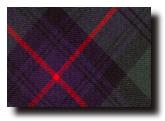
- Armstrong - Armstrong is a Lowland Scottish family name (that's its tartan shown here), though the name is also frequently encountered today both in England and in Ireland, having no doubt travelled there from Scotland. Scarlett (1975), an authority on Scottish clans and tartans, states the origin of the name as meaning 'strong arm', tradition holding that an early king of Scotland bestowed the name to his standard bearer who had bodily rescued the king when dismounted in battle.
- Blaine - Black (1996), the authority on Scottish family names, states that Blaine is a "reduced form of MacBlain". According to the House of Names Heraldic website, Blaine is a Scottish family name from Ayrshire. Its origin is said to be from the Gaelic bláán (yellow). The suburb of Blaine, in Anoka County, was named in 1877 by Moses Ripley, the first Chairman of the new township's Board of Supervisors. Ripley, who had come to Minnesota from Maine, persuaded his fellow Board Members to name the township in honour of James G. Blaine, a senator and three-time presidential candidate from Maine (Wikipedia article on Blaine, Minnesota, retrieved in January 2007). James G. Blaine (1830-1893), two-time U.S Secretary of State, was born in Washington County, Pennsylvania, of Scots-Irish stock (Wikipedia article on James G. Blaine, retrieved in January 2009).

- Calhoun Beach, Calhoun Isles, East Calhoun and West Calhoun - The names of these neighbourhoods are ultimately attributed to early surveyors who mapped the western lands in 1817. East and West Calhoun were named after the secretary of war at the time, John C. Calhoun. John Calhoun was also a congressman, senator, secretary of state and vice president (Minneapolis Neighborhood Profiles). Black (1996) mentions Calhoun as an American adaptation of the Scottish family name Colquhoun. Both names are pronounced the same. In Scotland, the name Colquhoun goes back to at least 1241. The family has long been associated with the village of Luss on the banks of Loch Lomond. Many are buried in the churchyard there and there is a fine crest above a set of gates on the main Loch Lomondside road (see illustration). Black also notes that several Colquhouns achieved distinction in Sweden and descendants of Walter Colquhoun, a 16th century iron founder, still exist there under names such as Cahun, Cahund, Caun, Gaan, Gahn and Kharun. According to the Ancestry.com website, Calhoun (as distinct from Colquhoun) is an Irish adaptation of Colquhoun, but Black is silent on Colquhouns moving to Ireland.
- Carag - this Celtic-looking name is actually an acronym: Calhoun Area Residents' Action Group (Minneapolis Neighborhood Profiles). Since the name of this neighbourhood refers to Calhoun (see entries above), a Scottish, or Scots-Irish, link can be claimed.
- Edina and Edina Mills - The name was chosen by Andrew and John Craik, Scottish immigrants from Canada who had moved to the area in 1869 and who had renamed the mill they purchased 'Edina Mill' after Edinburgh, the Craik brothers' boyhood home in Scotland (Upham, 2001).
- Elliot Park - there is a place called Elliot in the Scottish county of Angus. Elliot is a Scottish family name derived ultimately from the Old English Ælfwald, a common Saxon name on the Scottish Borders which was the original home of the Elliots. The Elliots later settled in Forfar (whence the modern place name in Angus) before heading south again, this time to Liddesdale where, by the late 16th century, "they had the doubtful honour of heading, with the Armstrongs, the list of the most unruly of the Border clans." (Scarlett, 1975, p. 60). The Wikipedia article on Elliot Park, Minneapolis, retrieved in January 2007, provides the following explanation for the name of this neighbourhood: "The namesake for the neighborhood is Mr. Joseph Elliot, an area physician, who donated his farm land to the city in 1893. This land is the site of the current Elliot Park, and another generous donation of Mr. Elliot resulted in the founding of Steele Park - these were the city's first two parks."

- Fulton (Dumfries & Galloway). Fulton is also a Scottish family name. Black (1996) notes that the name Thomas de Fulton is recorded around 1260 and Henry de Foultone of Lanarkshire rendered homage to King Edward I in 1296. The Minneapolis neighbourhood takes its name from Robert Fulton (pictured here), the American engineer and artist who invented the steamboat in the 19th century (Minneapolis Neighborhood Profiles). Robert Fulton (1765-1815) was of Ulster Scots (Scots-Irish) descent.
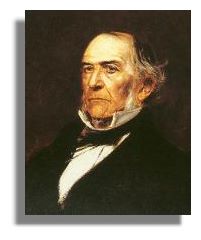
- Gladstone - there are places called Gladstone and Gladstone Boreland in South Lanarkshire, and Gladstone Farm in Renfrewshire. Gladstone is a Scottish family name, well established in Lanarkshire by the 13th century (Herbert de Gledstan was one of the signatories of the Ragman Roll). The most famous bearer of this name was William Ewart Gladstone (1809-1898), one of Queen Victoria's Prime Ministers, whose portrait is shown here. According to Upham (2001), the suburb in Ramsey County was indeed named for the British Prime Minister. Although William Ewart Gladstone was born in Liverpool, his parents were both Scottish and he proudly claimed that "not a drop of blood in my veins is not Scottish."
- Glendale (Highland) - This name proved to be a popular one during the 19th century, particularly in North America. The unusual feature of the name is that it is a tautology since it is based on two words (the Gaelic gleann and the Norse dalr) which both mean 'valley'.
- Glenwood Junction and Sumner-Glenwood - there is a village in Aberdeenshire called Glenwood. Sumner, on the other hand, is an English family name.
- Grant - there is a place called Grant in Perth & Kinross. There are also many other places in Scotland with this Scottish family name as part of the name, for example Grantlodge, Grantshouse and Grantown-on-Spey. Places beginning with Grant can also be found in England but in the majority of these instances 'Grant' has a different meaning.
- Highland and Highland Park - names possibly recalling the Highlands of Scotland. Highland Park is one of the most commonly recurring place names in North American cities, so much so that there seem to be two communities with this name in Minneapolis-St. Paul (a district of St. Paul and a suburb in Anoka County).
- Lauderdale (Scottish Borders). This suburb, in Ramsey County, was named for William Henry Lauderdale, veterinarian, dairy farmer and real estate businessman. Lauderdale was born in 1830 in New York, arrived in Hennepin County in 1854 and owned land in the area later known as Prospect Hills (Upham, 2001).
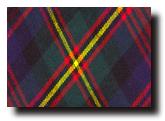
- Logan Park - there is a Logan in Dumfries & Galloway as well as in East Ayrshire (the latter being the likely origin of the Scottish family name Logan - that's its tartan shown here). "The neighborhood has many large Victorian houses and is built around Logan Park, a square dating back to the 1800s and named for Civil War general and U.S. Sen. John A. Logan." (Minneapolis Neighborhood Profiles).
- Macalester-Groveland - this St. Paul neighbourhood takes its name from Macalester College and Groveland Park. Macalester College (a Presbyterian college) was chartered in 1874 and was sponsored by Charles Macalester (1798-1873), a businessman from Philadelphia (Upham, 2001, and an article on Macalester College, retrieved from Wikipedia in January 2009). Black (1996) states that Macalester is one of the many variants of MacAlaster - son of Alexander. There are many records of the name in Scotland from 1455 onwards. Groveland, on the other hand, is probably of English or possibly German origin.
- McKinley - this Minneapolis neighbourhood and its elementary school were named for William McKinley, the 25th president of the United States (Minneapolis Neighborhood Profiles). According to the House of Names Heraldic website, the McKinleys originated in Perthshire. The Ancestry.com website suggests that McKinley is the Anglicized form of Gaelic Mac Fionnlaigh, a patronymic from the early personal name Fionnlaoch.
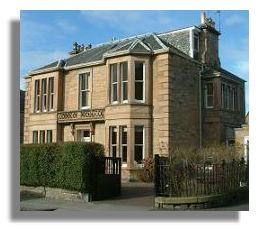
- Morningside - there are several places in Scotland called Morningside (in Dumfries & Galloway, North Lanarkshire, Perth & Kinross and, most famously, in the City of Edinburgh - illustrated here). Morningside is one of the most commonly recurring Scottish place names in cities around the world, especially in North America and South Africa. Upham (2001) states that Morningside was an 8,500-acre designed community for Minneapolis workers, and the first major residential development of Edina (see entry above) by C. I. Fuller. The suburb seceded from Edina on September 22, 1920, but returned in 1966. It seems highly probable that the neighbourhood was named for Morningside in Edinburgh.
- Northdale (Shetland Islands). Since this community is situated in Anoka County (in the northern suburbs), this is probably a descriptive name that happens, coincidentally, to be found only in Scotland and not elsewhere in the British Isles.
- Point Douglas - there is a Douglas in South Lanarkshire (the original territorial base of the powerful Douglas family) as well as in Ireland and on the Isle of Man. The Douglas family, descendants of William de Duglas (late 12th Century) was one of the most powerful in Scotland. A number of Douglas titles later devolved to the Duke of Hamilton and the eldest son of the Duke is now given the title of Marquess of Douglas. The Denmark Township Historical Society states that three pioneers - Hertzell, Burris and Hone - platted the village of Point Douglas in 1849 and named it for Senator Stephen Douglas, who was instrumental in forming the Minnesota Territory.
- Willard-Hay - This neighbourhood was named after two elementary schools within its borders: Francis Willard and John Hay. The former was named for an American educator, author and reformer born in 1859, and the latter honours an American diplomat and author born in 1839 (Minneapolis Neighborhood Profiles). Hay is a well-known Scottish family name, the earliest recorded use of the name being in regard to William de Haya, who came to Scotland from Normandy in about 1160. The family takes its name from La Haye, a place in Normandy, France, the meaning of which is 'the stockade' (Scarlett, 1975). Willard, on the other hand is an English family name (there is a Willard's Hill in Sussex) or, in the USA, an Americanised form of the German surname Willhardt, the meaning of which is cognate with Willard ('brave/hardy will/desire').
Some of the following localities may also prove on further investigation to have a link with Scotland. However, these names are also associated with other parts of the British Isles:
- Arden Hills - there are places called Arden in Argyll & Bute and in the City of Glasgow. Arden also occurs in other place names across Scotland, examples being Ardentallen and Ardentinny in Argyll & Bute, Ardendee in Dumfries & Galloway and Ardendrain in Highland. The name is not exclusively Scottish, however, since it occurs in many English place names, for example Henley-in-Arden in Warwickshire (referring to the Forest of Arden in Shakespeare's 'As You Like It'). According to Room (2003), Arden is a Celtic name meaning 'high district', from which source the name of the Ardennes, the forested hills in Belgium, is also derived. The Modern Gaelic word for 'high' is 'àrd'.
- Coates - there are places called Coates in the City of Edinburgh, East Lothian, Fife and Midlothian, but Coates also features in many English place names. Two differing explanations have been given for the origin of the name of the suburb of Coates, in Dakota County. Upham (2001), the authority on Minnesota place names, states that it was named for G.A. Coates, an early settler. A second theory credits "the great philosopher and early sports activist James T. Coates." (Wikipedia article on Coates, Minnesota, retrieved in July 2008). According to the Ancestry.com website, Coates is either an English family name (meaning 'cottager'), a variant of the Scottish family name Coutts (derived from a place in Aberdeenshire), or an Americanised spelling of the German-Jewish Kotz or the German Koths. These various possibilities greatly reduce the chance of a Scottish connection in the case of the Minneapolis suburb.
- Coopers Corner - places based on the family name Cooper are found throughout both Scotland and England. Scottish examples include Cooper Cleuch (Scottish Borders), Cooperhill (Aberdeenshire and East Ayrshire) and Cooper's Knowe (Highland). Upham (2001) provides the following explanation of the origin of the name of this suburb in Anoka County: "When the Great Northern Railway completed its line through the area in 1898 and the Bethel post office, established in 1863, was moved to a new townsite two miles west, becoming the present Bethel, the old site, which had a general store run by James Cooper, became known as Cooper's Corner."
- Deer Park (Dumfries & Galloway and Highland) also several places in England.

- Fletcher - Fletcher is certainly a Scottish family name. There is a Fletcher tartan and there is also a Fletcherfield in Angus possibly associated with the Fletchers of Innerpeffer. Since the origin of the name is purely occupational (meaning arrow-maker) it is hardly surprising that Fletcher is also found as an element in at least twelve place names throughout England, for example Fletchersbridge in Cornwall and Fletcher's Combe in Devon. Fletcher is also a relatively common English family name.
- Glen Lake - Glen, as an element in British place names, is an Anglicisation of the Celtic word for a valley (gleann in Gaelic and glyn in Welsh). Consequently, there are many places, particularly in Scotland and Ireland, with Glen as part of the name. Glen is also a Scottish family name. However, it is fairly widely distributed in Ireland and northern England as well as in Scotland. According to Upham (2001) "the original land grant, April 2, 1857, of 160 acres at the south end of Lake Minnetonka was owned by Mary and Robert Glen, later becoming the site of the Hennepin County Home School for Boys and the Glen Lake Sanatorium (state tuberculosis hospital)."
- Greenfield (City of Glasgow) also in England and Wales.
- Greenwood - there is a Greenwood in Moray, Scottish Borders and South Lanarkshire but Greenwood is also found in England and in County Mayo, Ireland.
- Hilltop (Dumfries & Galloway) but far more common throughout England (often spelled Hill Top) and also occurs in Ireland.
- Howe - there are places in Scotland called Howe (in Aberdeenshire, Highland and the Orkney Islands) but the name is also used frequently across England. In addition, there are numerous places in both England and Scotland with 'Howe' as an element in the name. As a family name, however, its origin is far more likely to be English than Scottish. The Minneapolis neighbourhood, like its elementary school, was named as a tribute to Julia Ward Howe (born 1819), the author of "The Battle Hymn of the Republic". (Minneapolis Neighborhood Profiles).
- Marshall Terrace - this neighbourhood was named after Minnesota's fifth governor, William R. Marshall, who served from 1866 to 1870 (Minneapolis Neighborhood Profiles). William Rainey Marshall (1825-1896) was born in Columbia, Missouri. It is not known whether he was ultimately of Scottish, Scots-Irish or English heritage, the family name Marshall (an occupational name from the Old French Mareschal) being strongly represented in both Scotland and in northern England. In Scotland, the Marshalls are a sept of Clan Keith.
- Newport (Highland) also in England, Ireland and Wales - Newport is Wales' third largest city and is also one of the best-known towns on the Isle of Wight in southern England.
- Oakwood (Scottish Borders, Moray and Perth & Kinross). However, this euphonious name is also used quite frequently for places in England.
- Roseville - as a place name in the British Isles, Roseville seems to occur only in the English midlands. However, this place is not the source of the name of the suburb in Ramsey County, which, according to Upham (2001) was named after one of the first settlers, Isaac Rose, who was also the postmaster between 1857 and 1861. Rose is a Scottish as well as an English family name, while in the USA, its origin could also be French, German or Yiddish.
- St Marys Point - there are places in Moray and Orkney Islands called St Marys but this is also the case in England.
- Weston - there are villages in Highland, Moray and South Lanarkshire called Weston; also Weston Burn in the Scottish Borders, but places called Weston are found far more commonly in England and the name is also used in Wales.
A final category of neighbourhood and suburban names comprises places that can be found in Scotland, or family names that could be Scottish but which, in the case of Minneapolis-St. Paul, definitely or most probably have no Scottish connection.
- Burnsville - Burns is a well-known Scottish family name. However, the suburb in Dakota County has no connection with Scotland. The name honours William Byrne, an early settler and landowner, who came to Minnesota in 1853 from Hamilton, Ontario, Canada. William Byrne had left his home in County Kilkenny, Ireland to settle in Canada in 1840. His family name had been recorded as Burns (presumably by an immigration official) and was never corrected (Upham, 2001 and Wikipedia article on Burnsville, Minnesota, retrieved in July 2008).
- Coon Lake Beach, Coon Rapids and West Coon Rapids - Coon is said to be a Scottish family name from Argyllshire (House of Names), and/or an Irish family name derived from the Gaelic 'O Cuana', related to Cooney (Ancestry.com). However, the origin of the names of these northern suburbs appears to be neither Scottish nor Irish since the reference is to raccoons that were often found in the former rapids of Coon Creek (Wikipedia article on Coon Rapids, Minnesota, retrieved in January 2007).

- Cooper - places based on the family name Cooper are found throughout both Scotland (that's their clan tartan here) and England (see Coopers Corner, above, for some Scottish examples). "The neighborhood's name is derived from an elementary school named after James Fenimore Cooper, an American novelist born in 1789." (Minneapolis Neighborhood Profiles). James Fenimore Cooper (1789-1851), author of 'The Last of the Mohicans', was born in Burlington, New Jersey of English Quaker descent.
- Eden Prairie - Eden occurs as a place name throughout the British Isles, being an Old Celtic name of several rivers, not to mention its biblical connotations. Scottish examples include Eden and Eden Hill in Argyll & Bute, and the river Eden in Fife. The origin of the name of this suburb in Hennepin County has no connection with any specific place in the British Isles. According to the article on Eden Prairie, Minnesota, retrieved from Wikipedia in January 2007, the City of Eden Prairie owes its name to Elizabeth Fries Ellet, an East Coast writer who visited the area in 1852. In her travelogue book, 'Summer Rambles in the West', Mrs. Ellet described the Minnesota River valley, which adjoins the present day City of Eden Prairie, as "the garden spot of the territory."
- Holland - there is a place called Holland in the Orkney Islands as well as in three English counties; there is also a Hollandbush in Stirling. Holland is an Old English name meaning 'land of hill spurs', though it may also refer to the Dutch province of Holland, a former administrative division of Lincolnshire or, in rare instances, the Anglicisation of an Irish personal name. The Minneapolis neighbourhood and its elementary school were named after Josiah Gilbert Holland, an American educator and editor born in 1819 in Massachusetts. "He was well known for Timothy Titcomb's Letters, a column he wrote for a newspaper in Springfield, Massachusetts." (Minneapolis Neighborhood Profiles). Being a New Englander, the likelihood of Josiah Holland having Scottish ancestry is greatly reduced.
- Inver Grove Heights - being an Anglicisation of the Gaelic word 'inbhir', meaning 'river mouth', Inver occurs as an element in many Scottish place names (Inverness, Invermay, Inverkeithing, etc.). However, since it is of Gaelic origin, the name also occurs in Ireland, though not so commonly as in Scotland. The suburb of Inver Grove actually has an Irish connection. According to Upham (2001), a pioneer by the name of John McGroarty named the town after a place in Ireland from which many of the settlers had come. In an article on Inver Grove Heights, retrieved from Wikipedia in July 2008, it is further stated that the town was named after an Irish fishing village called Inver, and the German town of Grove. Neither Inver nor Grove is traceable as a modern place name in Ireland and Germany.
- Linwood (Renfrewshire) also two places in England. Linwood is also an English and Scottish family name derived from the place name ('Lime tree wood'). However, there is no apparent link with either Scotland or England. As explained by Upham (2001), the suburb of Linwood in Anoka County "received its name from Linwood Lake, the largest and most attractive one in a series or chain of ten or more lakes extending from northeast to southwest through this township and onward to Ham Lake. The name doubtless refers to the lin tree or linden. Our American species (Tilia americana), usually called basswood, is abundant here and is common or frequent through nearly all this state."
- Lyndale - there is a Lyndale Point on Loch Snizort, the only occurrence of the name in the British Isles. However, according to the Minneapolis Neighborhood Profiles website, the neighborhood was named for Lyndale Avenue, which in turn takes its name from Lyndale farm, a 1,400-acre farm owned by the Hon. William S. King. "The name of the farm was in honor of Mr. King's father, Rev. Lyndon King, an itinerant Methodist minister of northern New York, who was named for Josiah Lyndon, colonial governor of Rhode Island in 1768-1769."
- Rosemount (Aberdeen City, Perth & Kinross and South Ayrshire) also in England and Ireland. There is no Scottish connection, however. Upham (2001) states that this suburb was named in the 1850s for a place in Ireland (presumably the small town in County Westmeath).
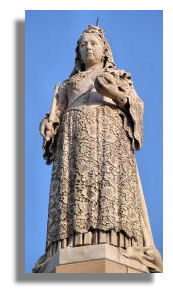
- Victoria (Perth & Kinross) also in England. Like most places named Victoria, the origin of the name of this community in Carver County is unlikely to refer to a place in Scotland or England. Upham (2001) states that it was, in fact, named for Queen Victoria (see Gladstone, above, as another example of a local place name honouring a world-famous British personality). The picture here is a statue of Queen Victoria on top of a fountain in Glasgow.
- Woodland - there is a place called Woodland in South Ayrshire as well as in five English counties. There is no Scottish connection, however, since the name of this suburb on Lake Minnetonka's Wayzata Bay was made up from the names of two communities that existed in the 1940s - Maplewoods and Groveland (Upham, 2001).
Many lakes, parks and golf courses throughout the metropolitan area also have names that are likely to be of Scottish origin. A few of these names could also prove to be English (e.g., Gray, Kellogg) or Irish (e.g., Kennedy, McMurray) but the vast majority are bound to have Scottish or Scots-Irish links. The following list is far from comprehensive - there may be several smaller parks and reserves whose names were not given on the maps that were consulted as well as larger parks in the outer suburbs.
- Anderson Lakes - lakes in Eden Prairie, Hennepin County. Anderson is a Scottish family name, though in North America its origin is often Scandinavian (Americanisation of Andersen).
- Bethune Park - a park in Minneapolis's Near-North neighbourhood. Bethune is a Scottish family name.
- Birnamwood - golf course in Burnsville, Dakota County. Birnam Wood, in Perth & Kinross, is the forest mentioned in Shakespeare's Macbeth.

- Braemar Park - golf course in Edina, Hennepin County. Braemar in Aberdeenshire is world famous as the venue for the annual Highland Gathering, patronised by royalty. The picture is of Mar Lodge, Braemar, Scotland.
- Brownie Lake - a small lake in Bryn Mawr, Minneapolis. Brownie is a Scottish family name.
- Burns Park - a small park in St. Paul's Battle Creek neighbourhood. Burns is a Scottish family name.
- Crosby Lake - a lake in Crosby Farm Park (large park in Highland, St. Paul). Crosby is a northern English and Scottish family name; in Scotland it is usually spelled Crosbie.
- Currie Park - a small park in Elliot Park, Minneapolis. Currie is a Scottish family name.
- Dunning Field - a park in St. Paul's Lexington-Hamline neighbourhood. Dunning is a Scottish and English family name; it is also an Irish variation of Downing.
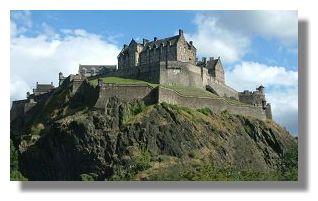
- Edinburgh USA - golf course in Brooklyn Park, Hennepin County. Edinburgh is the capital city of Scotland - that's Edinburgh Castle shown here.
- Elliot Park - a park in downtown Minneapolis. Elliot is a Scottish family name.
- Gray's Bay - a lake in Minnetonka, Hennepin County. Gray is a Scottish and northern English family name.
- Highlands Lake - a lake in Highlands Park, Edina, Hennepin County.
- Highland National Golf Course - golf course next to Highland Park, Highland, St. Paul.
- Irvine Park - a small park in St. Paul's West Seventh-Fort Road neighbourhood. Irvine is a Scottish family name.
- Kellogg Park - a park in downtown St. Paul. Kellogg is an English and Scottish family name.
- Kennedy Park - a park in West St. Paul. Kennedy is a Scottish and Irish family name.
- Laddie Lake - a lake in the northern suburbs, Anoka County. Laddie is a rare family name; during the 1890s, it was found in only one Scottish and two northern English counties (East Lothian, Durham and Yorkshire).
- Lake Calhoun - a lake in Minneapolis. Calhoun, as already noted, is an American variation of the Scottish family name Colquhoun.
- Lochness Park and Lochness Lake - a park and a lake in Blaine, Anoka County. Loch Ness (with its fabled monster) is one of Scotland's best-known lochs.
- McMurray Field - a park in St. Paul's Como Park neighbourhood. McMurray is an Irish and Scottish family name.
- McRae Park - a small park in Northrup, Minneapolis. McRae is a Scottish family name.
- Mitchell Lake - a lake in Eden Prairie, Hennepin County. Mitchell is a Scottish and English family name (more numerous in Scotland than in England).
- Morrison Park - a park in Minneapolis. Morrison is a Scottish family name.
- Prestwick - a golf course in Woodbury, Washington County. Prestwick is a Scottish and northern English place name.
- St Clair Playground - a small park in St. Paul's West Seventh-Fort Road neighbourhood. St Clair, a rare surname both in Scotland and in England, may refer to the Scottish family name from which Sinclair is derived.
- Stewart Field - a park in Phillips, Minnesota. Stewart is a Scottish family name.
- Tartan Park Golf Course - golf course near Lake Elmo, Washington County.

In company with most American cities, the Scottish influence on local place names in Minneapolis-St. Paul is not as marked as it is in the average Canadian, Australian, New Zealand or Caribbean city. However, compared with all other major American cities (metropolitan population of 1,000,000 or more) the use of names that are definitely or most probably Scottish or Scots-Irish appears to be above average, based on current estimates. In some ways this is an unexpected finding since the twin cities are not regarded as having a particularly strong Scottish heritage (that honour going to the Germans, Scandinavians and New Englanders). The only place names with a direct link to Scotland appear to be Afton, Edina, Morningside (probably) and Gladstone (more indirectly), together with the names of at least five golf courses, the others referring to pioneers and politicians with Scottish family names. Minneapolis-St. Paul's place names nevertheless provide a good American example of the far-reaching effects of the Scottish diaspora. Acknowledgements:
- Ayto, John & Crofton, Ian (2005). Brewer's Britain and Ireland: The History, Culture, Folklore and Etymology of 7500 Places in These Islands. (Weidenfeld & Nicolson, London).
- Black, George F. (1996). The Surnames of Scotland. (Birlinn Ltd, Edinburgh).
- Room, Adrian (2003). The Penguin Dictionary of British Place Names. (Penguin Books, London).
- Scarlett, James D. (1975). The Tartans of the Scottish Clans. (Collins, Glasgow and London).
- Upham, Warren (2001). Minnesota Place Names: A Geographical Encyclopedia (Third Edition).
- The Road Atlas '06 (Rand McNally).
- Mapquest.com and Yahoo Maps for the names of outlying suburbs.
- Minneapolis Neighborhood Profiles.
- Neighborhoods of Minneapolis.
- Saint Paul, Minnesota.
- Ancestry.com website.
- House of Names heraldic website.
- Websites, place name gazetteers and published Ordnance Survey maps of British and Irish cities, towns, villages and counties.
© Ian Kendall
If you wish to contact Ian about his research, his e-mail address is ian.kendall1@bigpond.com.
Melbourne, Australia, February 2009



